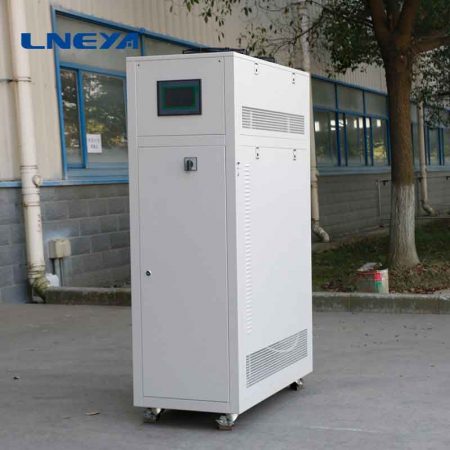Industrial Liquid Cooling System
完璧な温度制御ソリューションについては、今すぐお問い合わせください。
An industrial liquid cooling system is a way of dissipating heat from electronic equipment by flowing a liquid (usually water) through the heat sink of the electronic equipment, absorbing the heat generated by the equipment, and then removing the heat, thereby reducing the temperature of the equipment. Compared with traditional air cooling methods, liquid cooling can more effectively reduce the temperature of the equipment and improve the performance and life of the equipment.
Liquid cooling technology is mainly divided into two types: direct liquid cooling and indirect liquid cooling. Direct liquid cooling refers to flowing liquid directly through the radiator of the electronic device to remove the heat. Indirect liquid cooling involves flowing a liquid through a heat exchanger, transferring heat to another liquid through the heat exchanger, and then taking the heat away. Direct liquid cooling is more efficient but requires higher maintenance costs and a more complex design.
Liquid cooling technology has been widely used in high-performance computing, data centers, artificial intelligence and other fields. As the performance of electronic equipment continues to improve, heat dissipation issues have become more and more prominent. Liquid cooling technology will become one of the mainstream methods of heat dissipation for electronic equipment in the future.

The principle of industrial liquid cooling system:
The principle of industrial liquid cooling system is to reduce the temperature of the equipment by flowing liquid (usually water) through the radiator of electronic equipment, absorbing the heat generated by the equipment, and then taking the heat away. Liquids conduct heat better than air, so liquid cooling can remove the heat generated by the device faster.
Liquid cooling systems usually consist of radiators, water pumps, water pipes, and water tanks. Liquid cooling systems move liquid through a radiator, and the fins in the radiator allow the liquid to more easily absorb the heat generated by the device. The water pump then flows the liquid with the heat into the tank, where a radiator dissipates the heat to the surrounding environment. Liquid cooling systems can control the temperature of the device by adjusting water flow and water temperature.
Liquid cooling technology is mainly divided into two types: direct liquid cooling and indirect liquid cooling. Direct liquid cooling refers to flowing liquid directly through the radiator of the electronic device to remove the heat. Indirect liquid cooling involves flowing a liquid through a heat exchanger, transferring heat to another liquid through the heat exchanger, and then taking the heat away. Direct liquid cooling is more efficient but requires higher maintenance costs and a more complex design.
Advantages of industrial liquid cooling system:
Compared with traditional air cooling methods, industrial liquid cooling system has the following advantages:
Higher heat dissipation efficiency: Liquid cooling technology can reduce the temperature of the device more effectively and improve the performance and life of the device. Liquids conduct heat better than air, so liquid cooling can remove the heat generated by the device faster.
Lower noise: Compared with the noise generated by fans, liquid cooling has lower noise and can provide a quieter working environment.
More flexible design: Liquid cooling technology allows for more flexible design, and the radiator and liquid pipeline can be installed in different locations to better adapt to the design requirements of the equipment.
More environmentally friendly: Liquid cooling can save energy and reduce environmental impact. The liquid can be recycled more easily than the heat generated by the fan.
The disadvantages of liquid cooling technology are higher costs, higher maintenance costs and more complex designs. However, as the performance of electronic equipment continues to improve, heat dissipation issues have become more and more prominent. Liquid cooling technology will become one of the mainstream methods of heat dissipation for electronic equipment in the future.
Eメール info@lneya.com WeChat ID: +8615251628237 WhatsApp: +86 17851209193
 精密冷凍機/小型冷凍機
精密冷凍機/小型冷凍機
(カスタムデザイン)
チラーは様々な産業や研究所で広く使用することができ、カスタマイズされた設計をサポートしています。
| 温度範囲 | -18°C ~ +30°C | +5°C ~ +35°Cシリーズ |
| 冷却能力 | 0.35 ~ 0.9kW | 1.8~50kW |

循環式チラー
(カスタムデザイン)
私達の再循環のスリラーは低温冷凍の技術を採用し、温度は- 120℃と低く、さまざまな付属品はカスタマイズ可能です。
| 温度範囲 | -25°C ~ +30°Cシリーズ | -45°C ~ +30°Cシリーズ | -60°C ~ -20°Cシリーズ | -80°C ~ -20°Cシリーズ | -120°C ~ -70°Cシリーズ |
| 冷却能力 | 0.8 ~ 30kW | 0.75 ~ 12kW | 0.4 ~ 6kW | 0.2 ~ 6kW | 0.3 ~ 5kW |

低温チラー
(カスタムデザイン)
当社は、-150℃の温度制御範囲を持つ低温冷凍機の生産を専門としており、さまざまな業界の冷凍ニーズを満たすことができます。
| 温度範囲 | -25°C ~ -5°Cシリーズ | -45°C ~ -10°Cシリーズ | -60°C ~ -10°Cシリーズ | -80°C ~ -30°Cシリーズ | -110°C ~ -50°Cシリーズ | -150℃〜-110℃シリーズ |
| 冷却能力 | 12~360kW | 6~180kW | 6~180kW | 4〜180kW | 2~120kW | 2.5 ~ 11kW |
(カスタムデザイン)
車両品質テスト用温度シミュレーション:バッテリー寿命テスト、燃料噴射装置/モーターテストベンチ、エアバッグテスト、コンポーネントテストベンチなど。

(カスタムデザイン)
電子部品の精密な温度制御に適しています。過酷な環境に対応する半導体電子部品の製造では、ICパッケージの組み立てやエンジニアリング、製造テストの段階で、電子温度テストやその他の環境テストシミュレーションが行われます。

バッテリーエネルギー貯蔵システム用液体冷却
(カスタムデザイン)
| 種類 | コンバーティング・ステーション用 | 蓄電池用 | 充電ステーション用 |
| 冷却能力 | 45kW | 5 ~ 8.5kW | 4kW |

ZLFQシリーズ
(カスタムデザイン)
クーラント分配ユニット
液冷装置は、半導体試験、電子機器恒温試験、サーバー支持インフラ冷却、その他の流体温度制御場所に適しています。
| 温度範囲 | +5°C ~ +35°C | +5°C ~ +35°C |
| 冷却能力 | 15~150kW | 200~500kW |

MDサーマルチャックシリーズ
(カスタムデザイン)
RFデバイスや高密度パワーデバイス(IGBTやMOSFET)のテストに使用され、実験用フラットパネル(プラズマ、生物学的製品、バッテリー)などの急速冷却にも使用できる。
| 温度範囲 | -75°C ~ +225°C |
| 温度精度 | ±0.1℃ |

スクリュー冷凍機 (カスタムデザイン)
低温スクリュー冷凍機と常温スクリュー冷凍機
| 温度範囲 | +5°C ~ +30°C | +5°C ~ +30°C | +5°C ~ +30°C | +5°C ~ +30°C | -25°C ~ +5°C | -25°C ~ +5°C |
| 冷却能力 | 107~1027kW(シングルコンプレッサー) | 299~2134kW(デュアルコンプレッサー) | 98~934kW(シングルコンプレッサー) | 272~1940kW(デュアルコンプレッサー) | 48~467kW(シングルコンプレッサー) | 51~497kW(シングルコンプレッサー) |
 LNEYA
LNEYA
 简体中文
简体中文



















































































